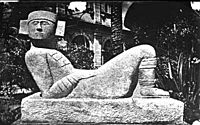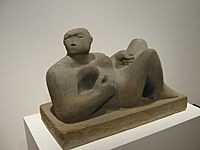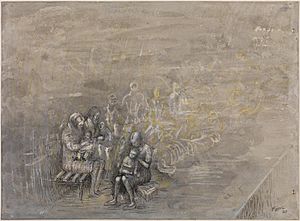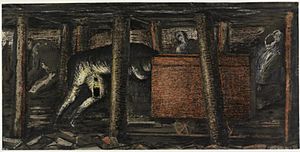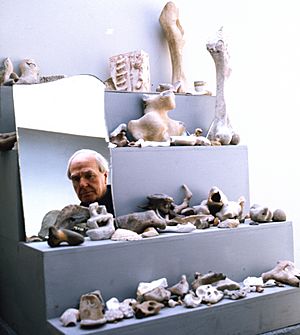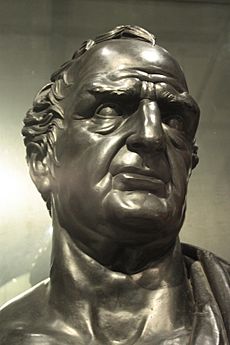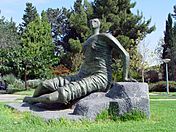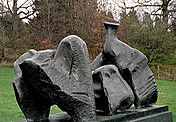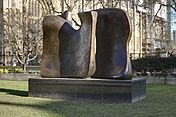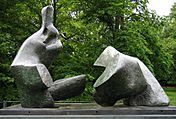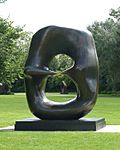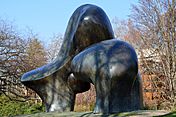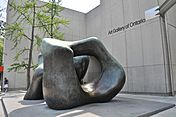Henry Moore facts for kids
Quick facts for kids
Henry Moore
|
|
|---|---|
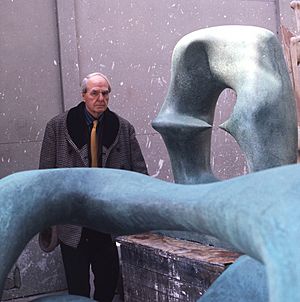
Moore in 1975
|
|
| Born |
Henry Spencer Moore
30 July 1898 Castleford, West Riding of Yorkshire, England
|
| Died | 31 August 1986 (aged 88) Much Hadham, Hertfordshire, England
|
| Education | Leeds School of Art Royal College of Art |
| Known for | Sculpture, drawing, graphics, textiles |
|
Notable work
|
List of sculptures |
| Movement | Bronze Sculpture, Modernism |
Henry Spencer Moore (born 30 July 1898, died 31 August 1986) was a famous English artist. He is best known for his huge bronze sculptures. You can find his amazing artworks all over the world in public places. Henry Moore also created many drawings.
The largest collection of Moore's art is open for everyone to see. It is kept at his home and the surrounding 70-acre estate. This was Moore's home for 40 years in Perry Green, Hertfordshire.
Even though his art made him a lot of money, Moore lived a simple life. Most of the money he earned went to the Henry Moore Foundation. This foundation still helps support art education and promotes the arts today.
Contents
Henry Moore's Early Life
Moore was born in Castleford, West Riding of Yorkshire, England. His parents were Mary and Raymond Spencer Moore. He was the seventh of eight children in his family. His family was very poor.
He went to infant and elementary schools in Castleford. There, he started making models from clay and carving wood. He was accepted into Castleford Secondary School. His headmaster quickly noticed his talent and interest in medieval sculpture.
Moore's first known carvings were made around this time. They included a plaque for the Scott Society at his school. He also made a Roll of Honour for boys who fought in the First World War.
At eighteen, Moore joined the army for the First World War. He was the youngest person in his regiment. In 1917, he was hurt in a gas attack during the Battle of Cambrai. After getting better in the hospital, he worked as a physical training instructor. He only returned to France when the war ended.
Becoming a Sculptor
After the war, Moore became a student at the Leeds School of Art. This school is now called Leeds Arts University. In 1921, Moore won a scholarship to study at the Royal College of Art in London.
While in London, Moore learned more about primitive art and sculpture. He studied the collections at the British Museum. In 1924, Moore won a scholarship to travel for six months. He spent this time in Northern Italy. There, he studied the famous works of Michelangelo, Giotto di Bondone, and other Old Masters.
During this trip, he also visited Paris. He took art classes and saw a plaster copy of a Toltec-Maya sculpture. This was the Chac Mool figure, which he had seen in books before. This reclining figure greatly influenced Moore's art. It became a main idea in his sculptures.
Life and Work in London

When Moore returned to London, he taught at the Royal College of Art for seven years. His first public artwork was West Wind (1928–29). This was one of eight carvings of the 'four winds' on the walls of London Underground's headquarters. Other artists also carved 'winds' for the building.
In 1928, Moore had his first solo art show. It was held at the Warren Gallery in London. In 1929, Moore and his wife, Irina, moved to a studio in Hampstead. In 1932, Moore became the Head of Sculpture at the Chelsea School of Art.
Henry Moore During World War II
When the Second World War started, the Chelsea School of Art moved away from London. Moore then left his teaching job. During the war, Moore made powerful drawings of Londoners. They were sleeping in the London Underground to hide from the Blitz bombings.
In August 1941, a committee asked Moore to draw miners. He drew them working underground at a coal mine in Yorkshire. His own father had worked there years before. Moore's drawings of people in shelters and miners working helped him become famous around the world.
After their home was damaged by a bomb in 1940, Moore and Irina moved. They left London for a farmhouse called Hoglands. It was in Perry Green, near Much Hadham, Hertfordshire. This became Moore's home and workshop for the rest of his life. In 1943, he was asked to carve a "Madonna and Child" sculpture for a church. This was the first of many important family-group sculptures he would create.
Later Years and Famous Works

.
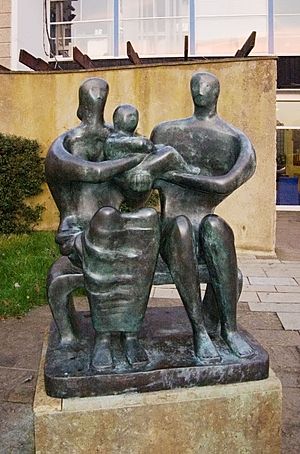
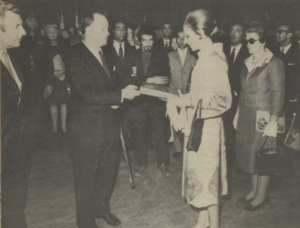
After the war, Moore made many "mother-and-child" sculptures. His reclining figures and hollow forms also remained popular. He visited America for the first time when his art show opened in New York City.
In the 1950s, Moore started getting more important art jobs. He showed Reclining Figure: Festival at the Festival of Britain in 1951. In 1958, he made a large marble reclining figure for the UNESCO building in Paris. As he created more public artworks, Moore's sculptures became much larger. He began to hire more assistants to help him.
Moore's Nuclear Energy was shown in Chicago in 1967. This was 25 years after scientists created the first controlled nuclear reaction. The 12-foot-tall sculpture is often thought to look like a mushroom cloud. But Moore had a different idea. He hoped people would "go around it, looking out through the open spaces, and that they may have a feeling of being in a cathedral." Moore also made a large bronze sundial for Chicago. It is called Man Enters the Cosmos (1980). This piece was made to celebrate space exploration.
In the last thirty years of Moore's life, he received more and more commissions. He finished Knife Edge Two Piece in 1962. It is near the Houses of Parliament in London. By the end of the 1970s, about 40 art shows a year featured his work.
Death
Moore died on 31 August 1986 at his home in Perry Green. He was buried in the churchyard of St Thomas's Church.
Henry Moore's Family Life
On 19 July 1929, Moore married Irina Radetsky. She was a painting student at the Royal College. Irina was born in Kyiv in 1907. Her father died in the Russian Revolution. Her mother moved to Paris and married a British army officer. Irina was later brought to Paris and went to school there. She then moved to live with her stepfather's family in Buckinghamshire.
Irina gave birth to their daughter, Mary Moore, in March 1946. The child was named after Moore's mother, who had died two years earlier.
Moore's Artistic Style
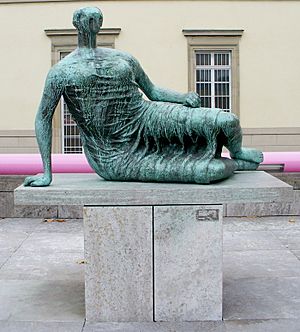
Moore's early work focused on direct carving. This means the artist carves the sculpture directly from a block of material. The shape of the sculpture develops as the artist removes pieces from the block.
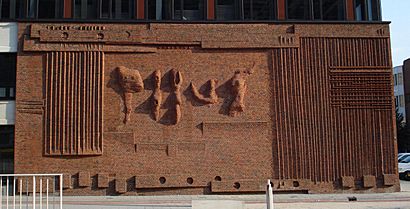

After the Second World War, Moore's bronze sculptures became much larger. He mostly stopped direct carving. Instead, he hired several assistants to help make the large forms. These were based on smaller models he created. By the late 1940s, he made sculptures more often by modeling. He would create the shape in clay or plaster. Then, the final work was cast in bronze using the lost wax method.
At his home, Moore collected natural objects. These included skulls, driftwood, pebbles, rocks, and shells. He used these to get ideas for his organic, natural-looking forms. For his biggest works, he usually made a half-size model first. Then, it was scaled up for the final moulding and casting at a bronze foundry. Moore often added details to the final plaster shape before it was cast.
Henry Moore's Legacy
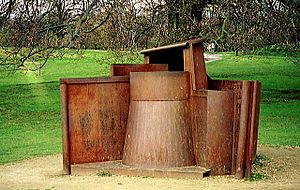
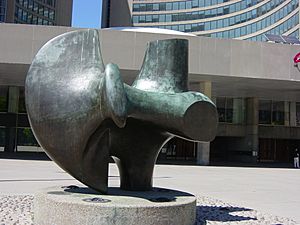
By the late 1940s, Moore was famous worldwide. He influenced many sculptors from Britain and other countries. Artists like Sir Anthony Caro, Phillip King, and Isaac Witkin have said Moore was important to their work. Other artists influenced by him include Helaine Blumenfeld, Lynn Chadwick, and Eduardo Paolozzi.
Awards and Recognition
In 1948, Moore won the International Sculpture Prize. This was at the Venice Biennale. He received the Companion of Honour in 1955. He also received the Order of Merit in 1963 and the Erasmus Prize in 1968. He was a member of important groups like the American Academy of Arts and Sciences.
He was also a trustee for the National Gallery and Tate Gallery. In 1975, he became the first President of the Turner Society.
Interesting Facts About Henry Moore
- Moore decided to become a sculptor when he was eleven years old. He heard about Michelangelo's achievements at Sunday School.
- Moore's parents did not want him to become a sculptor. They thought it was just manual labor with few job chances.
- Alice Gostick, Moore's art teacher at Castleford Secondary School, encouraged him to make art his career.
- Moore made many sketches and drawings for each sculpture. He thought drawing was very important. Most of these sketchbooks still exist.
- By the end of his career, Moore was the most successful living artist at art auctions.
- In 1951, Moore turned down a knighthood. He felt that such a title might separate him from other artists.
- The Henry Moore Foundation was started by Henry and his family in 1977 in England. It supports sculptors and helps people appreciate visual arts. The Foundation is still active today.
- The Henry Moore Sculpture Centre in the Art Gallery of Ontario, Toronto, opened in 1974. It has the world's largest public collection of Moore's work. He donated most of it between 1971 and 1974.
- Moore's Knife Edge Two Piece 1962–65 is displayed in Abingdon Street Gardens. It is opposite the Houses of Parliament. Because it often appears in news reports from Westminster, it is Moore's most famous piece in Britain.
- Moore gave 36 sculptures, drawings, and other works to the Tate Gallery in 1978.
- Moore's most recognizable shape is a reclining figure.
Henry Moore Quotes
- "Art is the expression of imagination, not the reproduction of reality."
- "To be an artist is to believe in life."
- "The soul cannot thrive in the absence of art."
- "I think in terms of the day's resolutions, not the years'."
- "One never knows what each day is going to bring. The important thing is to be open and ready for it."
Gallery
-
Draped Seated Woman (1957–58), Hebrew University of Jerusalem
-
Three Piece Reclining Figure No.1 (1961), Yorkshire Sculpture Park
-
Knife Edge Two Piece (1962–65) (bronze), (1962), opposite House of Lords, London
-
Knife Edge Two Piece (1962–65), Queen Elizabeth Park, Vancouver, B.C., Canada. 1970.
-
Two Piece Reclining Figure No. 5 (1963–64), bronze, Kenwood House grounds, London
-
Oval with Points (1968–70), Henry Moore Foundation
-
Sheep Piece (1971–72), Zürichhorn, Zürich-Seefeld, Switzerland
-
Large Two Forms (1969), Art Gallery of Ontario
See Also
 In Spanish: Henry Moore para niños
In Spanish: Henry Moore para niños
- List of sculptures by Henry Moore


